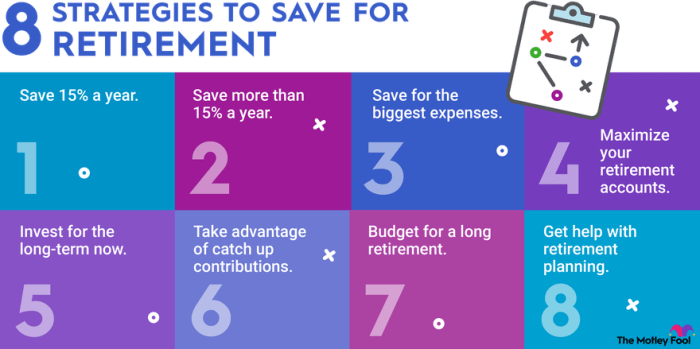When it comes to planning for retirement, one of the key aspects to consider is your investment strategy. This guide delves into different types of retirement investment strategies, risk management techniques, tax-efficient approaches, and long-term growth strategies. Let’s explore how you can make the most of your retirement savings and secure your financial future.
Types of Retirement Investment Strategies

When it comes to saving up for those golden years, there are a few different strategies you can use to make sure you’re living your best life when you retire. Let’s break down the main types of retirement investment strategies to help you decide which one is right for you.
Conservative Investment Strategy
When you play it safe with your retirement investments, you’re following a conservative strategy. This means sticking to low-risk options like bonds, certificates of deposit (CDs), or money market accounts. While you might not see huge returns right away, you can feel secure knowing your money is safe and steadily growing over time.
Moderate Investment Strategy
If you’re looking for a middle ground between safety and potential growth, a moderate investment strategy might be the way to go. This involves a mix of safe investments like bonds with some riskier options like stocks. By diversifying your portfolio, you can aim for solid returns without putting all your eggs in one basket.
Aggressive Investment Strategy
For those willing to take on more risk in exchange for potentially higher rewards, an aggressive investment strategy could be the ticket. This involves putting more money into stocks and other high-risk investments with the hope of seeing significant growth over time. While there’s a chance you could lose money, the potential for big returns is what draws many investors to this strategy.
So, whether you prefer to play it safe, strike a balance, or go all-in for the big wins, there’s a retirement investment strategy out there for you. Just remember to do your research and consult with a financial advisor to make sure you’re making the best choices for your future.
Risk Management in Retirement Investments
Investing for retirement can be a daunting task, but managing the risks associated with your investments is crucial to ensure a secure financial future. Let’s explore the importance of risk management in retirement investments and how you can protect your nest egg.
Diversification is a key strategy to mitigate risks in a retirement portfolio. By spreading your investments across different asset classes, industries, and geographical regions, you can reduce the impact of a downturn in any single investment. This way, you are less exposed to the risk of losing a significant portion of your savings if one particular investment performs poorly.
Diversification Strategies
- Allocate assets across stocks, bonds, real estate, and other investment vehicles to spread risk.
- Consider investing in both domestic and international markets to diversify geographically.
- Regularly rebalance your portfolio to maintain your desired asset allocation and risk level.
Managing Market Volatility
Market volatility can be unsettling, especially for retirees who rely on their investments for income. Here are some strategies to help you navigate market fluctuations and protect your retirement savings:
- Stay focused on your long-term goals and avoid making emotional decisions based on short-term market movements.
- Consider dollar-cost averaging, which involves investing a fixed amount of money at regular intervals to reduce the impact of market volatility.
- Review your risk tolerance and adjust your investment strategy accordingly to ensure you are comfortable with the level of risk in your portfolio.
Tax-Efficient Retirement Investment Strategies
When planning for retirement, it’s essential to consider tax-efficient investment strategies to maximize your savings. By understanding the tax advantages of different retirement accounts, such as traditional IRA, Roth IRA, and 401(k), you can make informed decisions to optimize your tax benefits.
Comparing Traditional IRA, Roth IRA, and 401(k)
- Traditional IRA: Contributions are tax-deductible, reducing your taxable income in the year you make the contribution. However, withdrawals during retirement are taxed as ordinary income.
- Roth IRA: Contributions are made with after-tax dollars, meaning withdrawals in retirement are tax-free. This can provide significant tax advantages in the long run.
- 401(k): Contributions are typically made with pre-tax dollars, lowering your taxable income. Withdrawals in retirement are taxed as ordinary income.
Maximizing tax benefits when investing for retirement involves strategically allocating your contributions across these different accounts based on your current and future tax situation.
Tips for Maximizing Tax Benefits
- Diversify your accounts: Consider a mix of traditional and Roth accounts to manage tax implications in retirement.
- Take advantage of employer matches: Contribute enough to your 401(k) to maximize any employer match, as this is essentially free money towards your retirement savings.
- Consider tax brackets: Depending on your current tax bracket and expected retirement income, choose the right account to optimize tax savings.
Long-Term Growth Strategies for Retirement
When planning for retirement, it is crucial to consider long-term growth strategies to ensure a financially secure future. These strategies focus on maximizing returns over an extended period to build a substantial nest egg.
The Power of Compounding Interest
Compounding interest is a powerful tool in retirement planning. By reinvesting earnings, you can generate returns on your returns, leading to exponential growth of your investments over time.
Asset Allocation Strategies
Proper asset allocation is key to achieving long-term growth in retirement investments. Diversifying your portfolio across different asset classes, such as stocks, bonds, and real estate, can help manage risk and maximize returns.